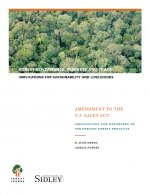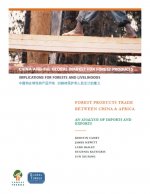Amendment to the U.S. Lacey Act
Implications for Chinese Forest Products Exporters
By R. Juge Gregg, Amelia Porges - Sidley Austin LLP, Sidley Austin LLP, Forest TrendsA recently passed law gives the U.S. government the power to fine, and even jail, individuals and companies who traffic in illegally harvested wood products. The U.S. government can even use this law, called the Lacey Act, to impose significant penalties on individuals and companies who do not realize that their wood is tainted. This […]
Dependent Documents
Chinese Version: Amendment to the U.S. Lacey Act
Implications for Chinese Forest Products Exporters
By R. Juge Gregg, Amelia Porges - Sidley Austin LLP, Sidley Austin LLP, Forset TrendsAmendment To The U.S. Lacey Act
Implications for Exporters of Indonesian Forest Products
By R. Juge Gregg, Amelia Porges - Sidley Austin LLP, Sidley Austin LLP, Forest TrendsA new law gives the U.S. government the power to fine, and even jail, individuals and companies who traffic in illegally harvested wood products. The U.S. government can even use this law, called the Lacey Act, to impose significant penalties on individuals and companies who do not realize that their wood is tainted. This new […]
Dependent Documents
Bahasa version: Amendment To The U.S. Lacey Act
Implications for Exporters of Indonesian Forest Products
By R. Juge Gregg, Amelia Porges - Sidley Austin LLPInvestment in the Liberian Forest Sector
A Roadmap to Legal Forest Operations in Liberia (English and Chinese)
By John Woods, Arthur G. Blundell, Robert Simpson - Forestry Development Authority of Liberia, UN Security Council Sanctions Committee on Liberia, U.S. Forest Service Office of International Programs, Forest Trends, UK Foreign and Commonwealth OfficeThis briefing document explains why Liberia needed reforms that ensure that logging no longer contributes to conflict in this country and how logging will be conducted under the new law and regulations that govern the management of Liberia’s forests.
Email Signup
Subscribe to any of Forest Trends’ mailing lists to keep up with the news, publications, and events that interest you.
Having Trouble?
If you experience any technical difficulties on our site, please contact Genevieve Bennett, Communications Manager.
Environmental Aspects of China’s Papermaking Fiber Supply
By Brian Stafford - Brian Stafford & Associates Pty Ltd:, Forest TrendsIn recent years, China’s expanding pulp and paper sector has become a major influence on the global forests and forest product markets. Since 1990, China has accounted for over 50 per cent the world’s overall growth in paper and paperboard production. To meet growing domestic demand, the government is promoting a new industry based on […]
Recent Developments in Forest Product Trade between Russia and China
Potential Production, Processing, Consumption and Trade Scenarios
By Steven Northway , Gary Q. Bull, Anatoly Shvidenko, Luke Bailey - University of British Columbia, Forest Trends, University of British Columbia, Faculty of ForestryChina has a very significant role in the global timber market and this has significant ramifications for forests, forest livelihoods and the structure of forest industries around the world. In this report we will focus on possible future trends in the forest products-processing, consumption and trade between China and its main suppliers, with a particular […]
Amendment to the U.S. Lacey Act
Implications for Malaysian Forest Products Exporters
By R. Juge Gregg , Amelia Porges - Sidley Austin LLP, Sidley Austin LLP, Forest TrendsMalaysia is one of the largest producers and suppliers of tropical hardwood and related products destined for the United States. In 2007, the United States imported almost 2.2 m3 RWE of timber products from Malaysia – mostly plywood and furniture – totaling USD$1.1 billion in value. Sabah and Sarawak supply the great majority of the […]
Linking FLEGT Voluntary Partnership Agreements to Jobs and Growth
Potential Challenges and Benefits for Small and Medium Sized Forest Enterprises
By Dominic Elson - DFID, Forest TrendsThis brief report discusses the potential impact of the European Commission’s Voluntary Partnership Agreements (VPAs) on the extent to which improved investment and business climates supported by VPA programs can support the small and medium forest enterprise (SMFE) sector. Recognizing the important roles that SMFEs play in rural development and the alleviation of rural poverty, […]
Forest Products Trade Between China & Africa
An Analysis of Imports & Exports
By Kerstin Canby, James Hewitt, Luke Bailey, Eugenia Katsigris, Xiufang Sun - Forest Trends, Forest Trends, Forest Trends, Forest Trends, Global TimberRecent reports of China’s efforts to secure access to natural resources in Africa suggest that timber has already become an important traded commodity between China and the African continent. Many hold a general impression that Africa exports a significant and growing amount of timber to China. However, the true magnitude of the China-Africa forest product […]
Forest Certification and Communities
Looking Forward to the Next Decade
By Augusta Molnar et al. - Forest TrendsThis review looks at the experience with communities and certification as the first in a series of systematic reviews of certification. The analysis includes an assessment of community experiences with certification to date, an evaluation of the range of direct and indirect impacts on communities in different geographic regions, and an examination of the strategic […]
Dependent Documents
Annex 1: Forest Certification in Brazil
The Parallel Evolution of Community Forest Management in the Brazilian Amazon and FSC Certification
Annex 2: Forest Certification in Guatemala
The Process of Forest Certification in the Mayan Biosphere Reserve in Petan, Guatemala
By Carlos Soza - Forest TrendsAnnex 3: Forest Certification in Mexico
Certification in Mexico: The Cases of Durango and Oaxaca
By Sergio Madrid, Francisco Chapela - CCMSS, ERA, Forest TrendsChina and the Global Market for Forest Products
Transforming Trade to Benefit Forests and Livelihoods
By Andy White, Xiufang Sun, Kerstin Canby, Jintao Xu, Christopher Barr, Eugenia Katsigris, Gary Bull, Christian Cossalter, Sten Nilsson - Forest Trends, Forest Trends, Forest Trends, Center for Chinese Agricultural Policy, CIFOR, Forest Trends, University of British columbia, CIFOR, IIASA, Rights & Resources InitiativeChina’s spectacular economic growth over the last decade is having a dramatic impact throughout the world. It has become a leading nation in terms of its demand for forest products, and its influence is being felt as far afield as Cameroon and Cambodia, Indonesia and the United States. China is now in the world’s spotlight, […]















